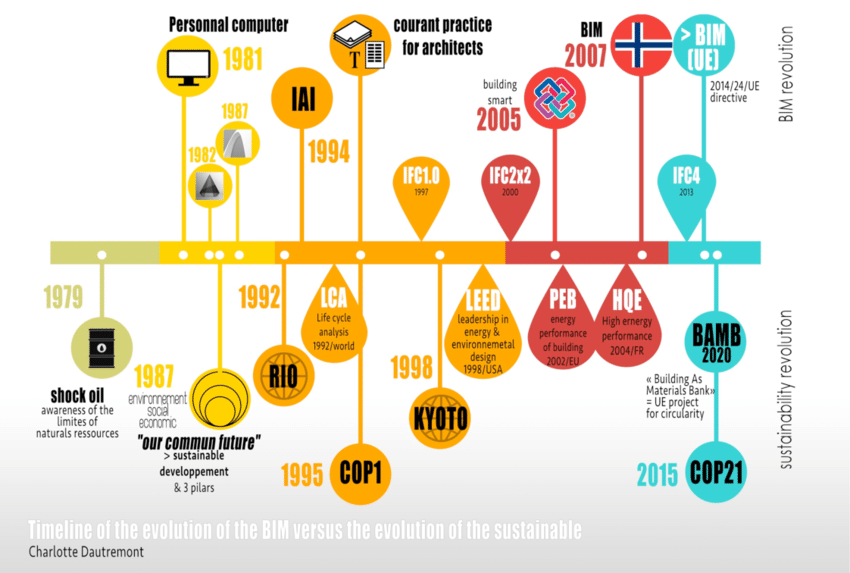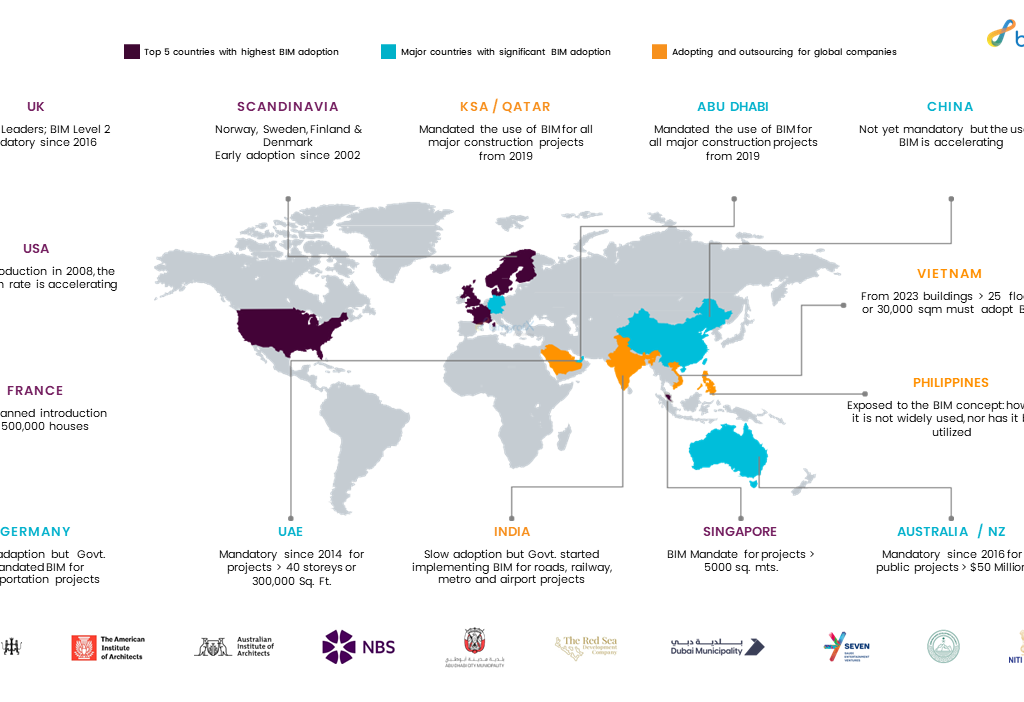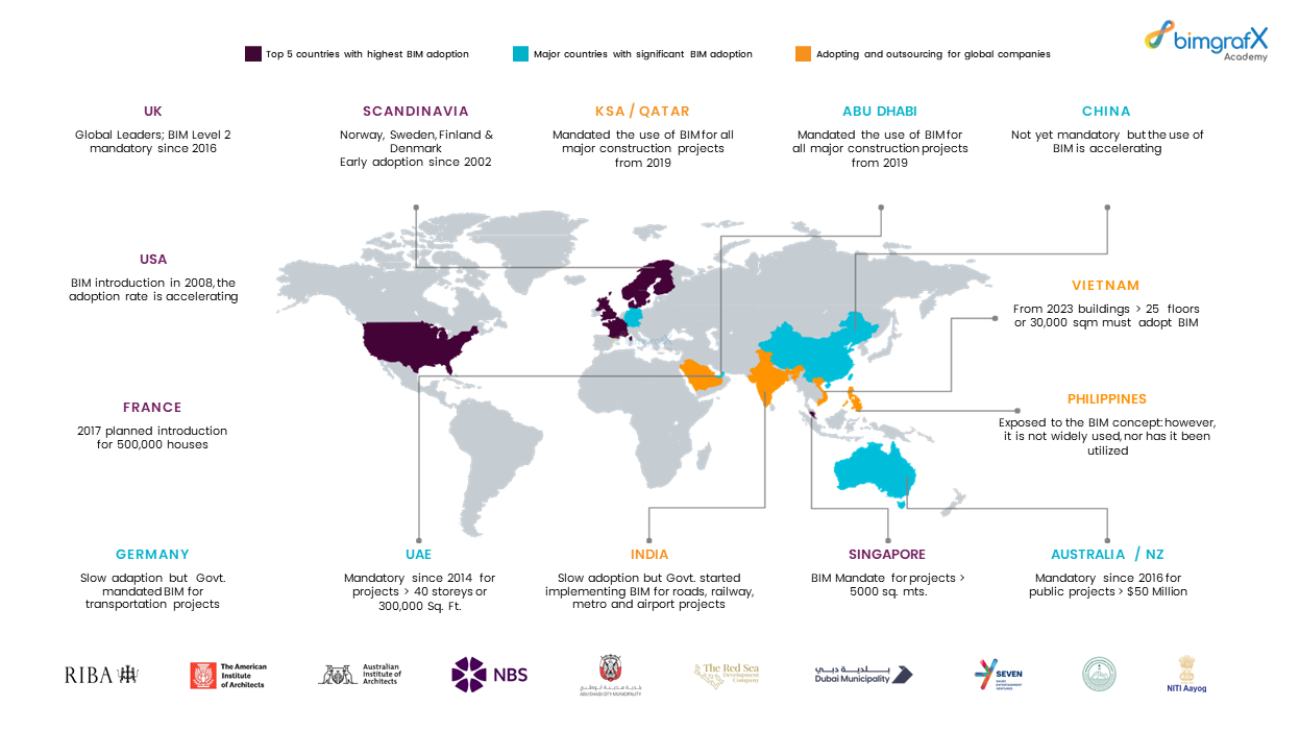Building Information Modeling (BIM) has transcended borders, becoming a cornerstone of modern construction practices worldwide. From its inception to widespread adoption, the journey of BIM has been marked by both triumphs and challenges. In this blog, we’ll explore the global landscape of BIM adoption.
If you are wondering if and why you need to transition to BIM, make sure to read:
AEC in Transition: Traditional v/s BIM Professionals
Timeline
Emergence (1970s-1990s):
1957: First Computer-aided machining software (CAM)
The inception of Computer-aided machining software laid the groundwork for the digital revolution in design and construction.
1963: Sketchpad, CAD with graphical user interface
Sketchpad introduced the concept of Computer-Aided Design (CAD) with a graphical user interface, revolutionising how architects and engineers interacted with digital design tools.
1982: 2D CAD
The emergence of 2D CAD software enabled architects and engineers to create digital representations of building plans and schematics.
1985: Vectorworks
Vectorworks introduced innovative tools for architectural design, laying the foundation for future BIM software development.
1992: Building Information Model – officially
The official recognition of Building Information Modeling (BIM) laid the foundation for its widespread adoption in the construction industry.
Early Adoption (2000s):
The early 2000s saw a surge in BIM adoption as AEC firms recognized its potential for enhancing collaboration and streamlining workflows. Software innovations alongside growing client demands for efficiency catapulted BIM into the mainstream.
2000: Revit
The launch of Revit marked a significant milestone in BIM technology, offering integrated solutions for architectural, structural, and MEP design.
2001: NavisWorks
NavisWorks introduced advanced tools for project coordination and clash detection, enhancing collaboration among multidisciplinary teams. 2002: Autodesk takes over Revit
Autodesk’s acquisition of Revit signalled a new era of innovation and investment in BIM technology.
2004: Revit 6 update
The Revit 6 update introduced new features and enhancements, further solidifying its position as a leading BIM platform.
2006: Digital Project
Digital Project expanded the capabilities of BIM software, offering advanced tools for large-scale architectural projects.
2007: Autodesk takes over NavisWorks
Autodesk’s acquisition of NavisWorks strengthened its portfolio of BIM solutions, enhancing project coordination and collaboration capabilities.
Maturation and Mandates (2010s):
The 2010s marked a period of maturation for BIM, fueled by government mandates and industry initiatives. Countries like the UK and Singapore implemented BIM mandates, leading to widespread adoption and standardisation. BIM transitioned from novelty to necessity for AEC professionals worldwide The Rise of BIM on a Global Scale.
Global Expansion (2020s-Present):

In recent years, BIM has transcended borders, spreading to every corner of the globe. The evolution of BIM has been marked by significant milestones, from the introduction of early CAD software in the 1960s to the development of sophisticated BIM platforms like Revit. With each advancement, BIM has revolutionised the way buildings are designed, constructed, and maintained, paving the way for a more sustainable and efficient built environment The Rise of BIM on a Global Scale.
BIM Adoption Worldwide: A Deeper Dive

North America:
- North America leads in BIM adoption due to government initiatives, industry leadership, and technological innovation.
- In the United States, the GSA BIM Guide and U.S. Army Corps of Engineers’ mandates have driven widespread BIM adoption in federal projects.
- Leading AEC firms like Skanska and Turner Construction leverage BIM for collaboration, clash detection, and project visualisation.
- Professional organisations such as the American Institute of Architects and the American Society of Civil Engineers play key roles in promoting BIM education and best practices.
- Canada mirrors this momentum with agencies like Infrastructure Canada advocating for BIM. Major cities like Toronto and Vancouver enforce BIM usage on public projects.
- Canadian firms like EllisDon and PCL Construction are leaders in BIM implementation, fostering innovation and collaboration.
Europe:
- Europe emerges as a global BIM leader with ambitious mandates and initiatives driving digital transformation in construction.
- The UK’s BIM Level 2 mandate requires government projects to adopt BIM, resulting in efficiency gains and cost savings.
- Organisations like BuildingSMART UK & Ireland and the UK BIM Alliance promote BIM education and standardisation efforts.
- In Germany, the BIM Task Group and VBI advance BIM adoption, with initiatives like DigiBau focusing on interoperability.
- Scandinavian countries like Norway and Finland use BIM to drive sustainability and innovation, with government-led initiatives fostering collaboration.
Asia:
- Asia-Pacific experiences rapid BIM adoption driven by urbanisation, infrastructure development, and government initiatives.
- China’s “Made in China 2025” initiative prioritises BIM for digital transformation, with major cities implementing BIM mandates.
- Japan’s Ministry of Land, Infrastructure, Transport and Tourism promotes BIM adoption through the BIM Promotion Council, facilitating collaboration across sectors.
- Singapore leads BIM adoption in Southeast Asia with the BIM e-submission mandate, driving efficiency and transparency in construction projects.
Middle East and Africa:
- The Middle East and Africa recognize BIM’s potential for efficiency and innovation in construction.
- The UAE’s Dubai Municipality mandates BIM usage on major projects, driving adoption and investment.
- Saudi Arabia‘s Vision 2030 emphasises digital transformation, with BIM enhancing project delivery and asset management.
- South Africa embraces BIM for sustainable development, with initiatives like the National BIM Guideline Framework promoting collaboration and interoperability.
bimgrafX globally
bimgrafX Academy, as an Authorised Autodesk and SketchUp Training Partner, actively participates in BIM implementation and conducts BIM awareness programs across India with a mission of raising BIM professionals to the globally growing BIM industry. We offer comprehensive training to students & professionals in the AEC segment.
Check out: https://bimgrafxacademy.com/.
bimgrafX , a global leader in BIM solutions, has made significant contributions to projects worldwide. In the UAE, we collaborated on various pavillions at Expo 2020 such as the Mobility Pavilion, Firdaus Orchestra, etc delivering BIM models for architectural, structural, and MEP services. Additionally, we were involved in the Pinnacle Towers project in Nairobi, Kenya, delivering clash-free models. Our impact also extends to projects like the Laboratory in Seattle, USA to replace inefficient heating systems, showcasing The Rise of BIM on a Global Scale our commitment to efficiency and innovation globally.
Through our unwavering commitment to excellence and innovation, bimgrafX collectively continues to leave a transformative mark on projects worldwide with our teams in India, UAE and the USA as well.
Conclusion
BIM adoption worldwide is like a big puzzle with different pieces – regional policies, industry leaders, and cutting-edge technology. All around the globe, construction is going digital, thanks to BIM. As folks in the industry get on board with BIM and figure out the tricky bits, we’re moving closer to buildings being built faster, better, and greener. Let’s team up and use BIM to make our cities and towns awesome places to live and work!
